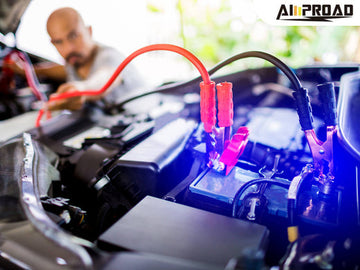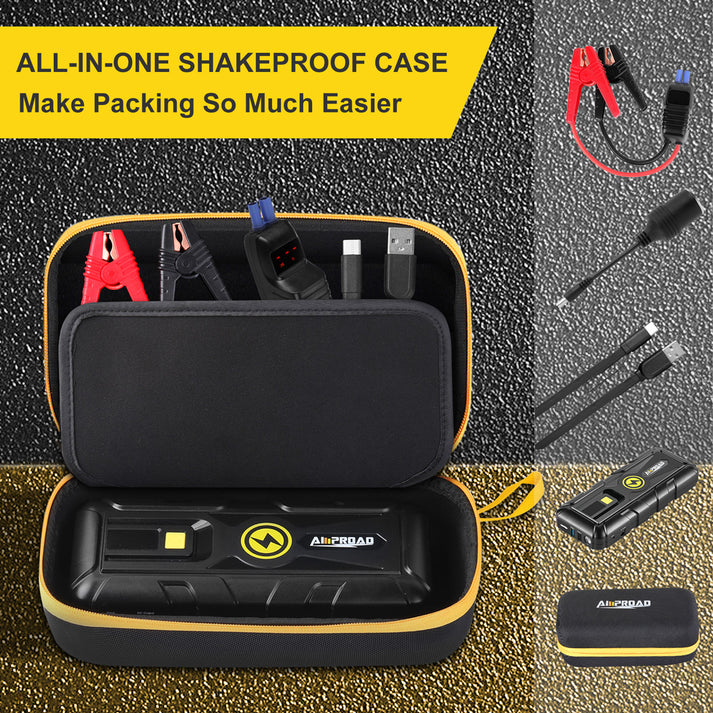
The scenario is familiar: you turn the key, and instead of the familiar hum of a revving engine, you're met with silence or the dreaded clicking sound. Could it be a bad starter? The question then arises: will a jump-start work when your starter is on the fritz?
Will a Jump-start Work with a Bad Starter?
In many cases, a jump-start can indeed breathe temporary life into a car with a bad starter. However, the effectiveness depends on the specific nature of the starter issue.

Starter Motor Problems:
If the starter motor is the culprit, a jump-start might offer a temporary solution. When a starter motor is failing, it may struggle to initiate the engine's crank. Jump-starting provides an external surge of power, sometimes giving the weakened starter the boost it needs to engage.
Starter Solenoid Issues:
The starter solenoid plays a crucial role in the starting process. If it's malfunctioning, a jump-start may not be as effective. The solenoid is responsible for transmitting the electrical signal from the ignition switch to the starter motor. If this linkage is compromised, additional power from a jump-start might not address the underlying solenoid problem.
Additional Considerations:
Battery Health: Before attempting a jump-start, assess the health of your battery. If the battery is also weak or failing, a jump-start might not provide sufficient power to overcome both battery and starter issues.
Repeated Attempts: In some cases, repeated jump-start attempts might be necessary. This could potentially overcome temporary resistance or obstruction within the starter motor.
While a jump-start can be a quick and convenient solution for addressing certain starter issues, it's essential to recognize its limitations. A jump-start does not fix the root cause of a bad starter; it merely offers a temporary workaround. If your car consistently struggles to start, seeking professional inspection and potential starter replacement is advisable.
Moreover, if a jump-start proves ineffective, it could signal a more severe problem, such as a failed starter or other underlying issues in the starting system. In such cases, relying solely on jump-starting might become impractical, and a thorough diagnosis by a qualified mechanic becomes imperative.
Thousands Trust AMPROAD iRock40.
Get Unstuck
How Do You Know If Your Starter Is Bad or Battery?
When your car refuses to start, deciphering whether the culprit is a bad starter or a weak battery becomes a critical puzzle. Recognizing the distinctive signs of each issue is key to effective troubleshooting.
A bad starter often reveals itself through telltale signs like a clicking noise, a high-pitched whirring sound, or even smoke and a burning smell near the starter. These symptoms indicate potential problems with the starter motor or its engagement with the engine.
On the other hand, a weak battery exhibits its own set of indications, such as dimming lights, slow cranking, and a repetitive clicking sound during starting attempts. These signs point to insufficient power to kickstart the engine.
To diagnose the problem, consider checking the lights and accessories. If they remain bright during starting attempts, the issue may lean more towards a bad starter. Conversely, if jump-starting the car successfully resolves the problem, it suggests a weak battery.
Understanding these distinctions allows you to approach the troubleshooting process with clarity. Whether it's the distinct sounds of a malfunctioning starter or the subtle hints of a struggling battery, discerning between the two ensures you take the appropriate steps to revive your car and get back on the road. If uncertainty persists, seeking professional diagnostic assistance can provide a conclusive solution to your starting woes.
Why the Jump Starter Won’t Work?
Facing a car that refuses to start can be a frustrating experience, especially when a vehicle jump starter, a seemingly handy solution, fails to do the trick. If you find yourself wondering why the jumper starter won't work, there are several potential factors at play.
Failed Starter
While a jumper starter can revive a weakened battery, it won't remedy a faulty starter. If your car's starter has reached the end of its lifespan or is experiencing internal issues, a jump starter won't be sufficient to initiate the engine's crank. In this case, a professional inspection and potential starter replacement may be necessary.
Starter Solenoid Issues
The starter solenoid, responsible for transmitting the electrical signal from the ignition switch to the starter motor, can also be a source of trouble. If the solenoid is failing, the jump starter's boost may not effectively engage the starter motor. Solenoid issues often require a more detailed examination and potential replacement.

Corroded Battery Terminals
Corrosion on the battery terminals can impede the flow of electricity, hindering the effectiveness of a jumping starter. Before attempting a jump-start, inspect the battery terminals for corrosion. If present, cleaning the terminals with a wire brush and ensuring a secure connection may enhance the jump-start process.
Read More: Ultimate Guide To Clean And Remove Car Battery Corrosion (amproad.ca)
Weak or Dead Battery
A jump starter's primary function is to provide an external power source to jump-start a vehicle. However, if the battery is weak or completely dead, the jump starter may struggle to deliver the necessary power. In such cases, allowing the jump starter to charge the battery for a longer duration before attempting to start the car can improve the chances of success.
Issues with Jump Starter Unit
The jump starter itself may be experiencing malfunctions. This could include a depleted internal battery, damaged cables, or a faulty power button. Regular maintenance and testing of the vehicle battery booster unit are essential to ensure its reliability when needed.
Incorrect Jump-Starting Procedure
Following the correct jump-starting procedure is crucial for success. Connecting the jump starter cables incorrectly – such as reversing the polarity – can lead to electrical damage and render the car jump starter ineffective. Always refer to your vehicle's manual for proper jump-starting instructions.
Fuse Issues
Some vehicles have fuses or fusible links in the starting system. If a fuse related to the starting system is blown, it can prevent the car battery booster from effectively delivering power to the battery. Checking and replacing any blown fuses can address this issue.
Underlying Electrical Problems
If your car exhibits persistent starting issues, there may be underlying electrical problems beyond a weak battery or a bad starter. Faulty ignition switches, damaged wiring, or problems with the engine control module could hinder the effectiveness of a jump starter.
As a final point, while car battery boosters are valuable tools for addressing certain starting issues, their success hinges on various factors. Recognizing the limitations of a jump starter and understanding potential issues with the starter, solenoid, battery, or even the jump starter unit itself empowers you to troubleshoot effectively. If the jump starter proves unsuccessful, seeking professional assistance for a comprehensive diagnosis and resolution of underlying problems is recommended.
How to Start a Car with a Bad Starter?
When faced with a car that has a bad starter, the frustration can be palpable. However, there are methods to kickstart your vehicle even with a faltering starter. One effective approach involves using a jump starter.
Amproad, a renowned manufacturer specializing in professional jump starters, offers reliable solutions for such situations. To start your car with a bad starter using a starter jumper, follow these steps:
Position the Vehicles:
Place both the functioning vehicle and your car in close proximity, ensuring the starter jumper cables can reach both batteries without strain.
Turn Off Ignition:
Ensure that both cars are turned off before connecting the car jump box. Safety is paramount in this process.
Connect the Jump Starter:
Attach the positive (red) cable from the jump starter to the positive terminal of the dead battery. Then, connect the negative (black) cable to the jump starter and attach the other end to a metal surface on the car with the working battery – this serves as a ground.
Power Up the Jump Starter:
Activate the jump starter and allow it to power up. Many Amproad jump starters come with additional features like built-in safety mechanisms and USB ports.
Start the Working Vehicle:
Turn on the engine of the car with the functional battery. Allow it to run for a few minutes to provide a charge to the dead battery.
Attempt to Start Your Car:
Try starting your car. The car jump box should supply the necessary power to overcome the bad starter and initiate the engine's crank.
Disconnect Cables:
Once your car is successfully started, disconnect the battery booster cables in the reverse order of connection – negative first, then positive.
Amproad's jump starters are designed with user convenience and safety in mind. Their products often feature intelligent clamps with reverse polarity protection, preventing damage in case of incorrect connections. Additionally, Amproad's jump starters are compact and portable, making them a practical and efficient solution for starting a car with a bad starter.
While jump-starting can be a temporary fix, it's advisable to seek professional assistance to diagnose and address the underlying issues with the bad starter. Amproad's commitment to quality and innovation ensures that their jump starters provide a reliable and effective means to revive your vehicle when faced with a troublesome starter.
Related Contents:
How to Boost a Car?
Can You Jump Start a Car with a Bad Alternator?
What Is the Differences Among Jump Starter, Jumper Cables, and Jump Box?
How to Use Jump Cables?


